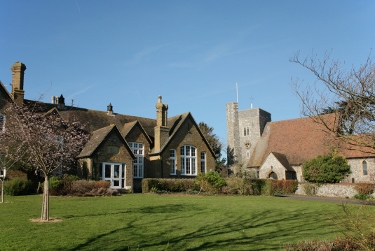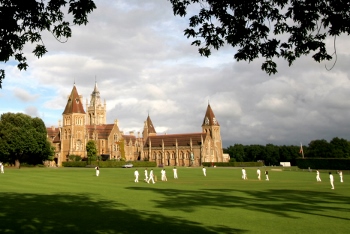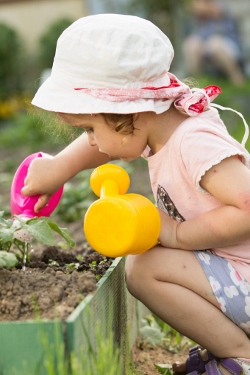Finding a School
 If you are lucky enough to have children or are planning to have some, then the benefits of living in the country are manifold. 'A better environment to bring my kids up in' has almost become synonymous with 'a move to the country' and the numerous joys, pleasures and health advantages of living in the country that you will realise will be more than matched by the benefits your children will enjoy.
If you are lucky enough to have children or are planning to have some, then the benefits of living in the country are manifold. 'A better environment to bring my kids up in' has almost become synonymous with 'a move to the country' and the numerous joys, pleasures and health advantages of living in the country that you will realise will be more than matched by the benefits your children will enjoy.
In the country there is a wide selection of schools to consider and finding the right school or nursery is of course paramount so careful planning is recommended. Even though schools are considered better across the board than city schools, many families making the move will find their schools first and then look for a house within catchment or within range. There are two main types of school; state schools, which are free, and independent schools, which are paid for. Some families will fall firmly into one camp or the other but many people will be undecided or may find a mixture suits them and their children. Within each sector there is variation, even within the age ranges, so there is much to consider.
Many families making the move out of London will even find the schools first and only afterwards look for a house within catchment or in range.
STATE SCHOOLS
- Admissions are made through the relevant local council and either all or the vast majority of funding is from central government either via the local authorities or directly.
- There are, these days, lots of different ways that state maintained schools are managed – Voluntary Controlled, Voluntary Aided Church Schools, Community Schools, Academies, Trust Schools and Free Schools.
- Differences in the management set up will determine how governors are appointed, admissions policies, term dates and school hours, how school meals are provided, staff pay and conditions and importantly, how or if the National Curriculum is followed.
- However it is that a state maintained school is managed, it will appear on the performance tables and be subject to OFSTED inspections. All this is available to view on-line.
- OFSTED is the ‘Office for Standards in Education, Children’s Services and Skills’. See more about Ofsted and performance tables below.
- One difficulty with all state schools is that you cannot apply for a place until you have proof of a confirmed address in the area. This will add stress to any house move, but schools in general are understanding and helpful and will try and let you know if your child is likely to get a place once your move has been made.
- Unless your children are pre-school age, or you have made very careful planning, you are not likely to be moving at a convenient start point for one of the school stages.
- In this case you will have to make what is known as an ‘In Year’ or ‘Casual’ admission.
- Talk to your preferred schools first, and then use the ‘In Year’ admission forms available from the Local Education Authority.
- Success will depend on the schools admission criteria which will include distance from the school.
- For grammar schools it will also include an ability test.
- For all schools it will be dependent on places being available in your child’s year group. Even the most popular schools have families moving away, often giving their school little notice, so it is well worth keeping in touch with your preferred school as your moving plans progress.
State Primary Schools - for age rising 5 to 11.
 In the country, small village schools with paternal teachers and head mistresses or masters with a care for the local community, do still very much exist. These may, or may not, be a Church of England school with strong links to the village church which is, as often as not, next door. Usually housed in the original Victorian building with add-on classrooms, a playground and playing fields, they do not have the facilities to rival an independent prep school, but the best will have been enhanced by parent fund raising and involvement in extra-curricular activities, and will have caring, committed teaching staff and a friendly atmosphere.
In the country, small village schools with paternal teachers and head mistresses or masters with a care for the local community, do still very much exist. These may, or may not, be a Church of England school with strong links to the village church which is, as often as not, next door. Usually housed in the original Victorian building with add-on classrooms, a playground and playing fields, they do not have the facilities to rival an independent prep school, but the best will have been enhanced by parent fund raising and involvement in extra-curricular activities, and will have caring, committed teaching staff and a friendly atmosphere.
- Some of the most successful and popular of such schools are small, with an annual intake of less than the standard class size. The result is mixed age classes with the 7 year groups (reception + 1 – 6) being split between 4 or 5 classes.
- Other larger village schools will have one year group to one class with one teacher, a few will have two classes in each year, but rarely more.
- In the larger villages or towns there may be separate infant and junior schools, juniors from age 7, or there may be more than one primary school.
- Whilst Catholic primary schools are found in some of the medium sized and larger towns country, other faith school are rarely found outside the cities or large towns.
- The most popular village primaries are often over-subscribed, especially at Reception entry level. Those with a sibling already in the school will get preference, after that, distance from the school counts and Church schools may well have additional criteria.
Primary School Performance and OFSTED Reports - https://www.gov.uk/school-performance-tables
Primary schools are evaluated on school performance tables and these are compiled from the outcome of SATS (Standard Assessment Tests). These ‘league tables’ will show what percentage of the children tested in year 6 in primary schools achieve a desired level and also a progress score for the core subjects. The SAT results and these tables are relied on to give an indication of the quality of teaching in the schools. It must be remembered though, that these are something of a ‘snap shot’ of the ability of a group of perhaps as few as 15 children of ten or eleven years of age. The potential ability will vary from year to year and from school to school.
These tables will also link to the current OFSTED inspection outcome for each school. ‘1’ represents outstanding, ‘2’ good, ‘3’ satisfactory, ‘4’ inadequate. The inspections are carried out once every 3 to 4 years, or more often if deemed necessary. For most primary schools this will be a two day visit for which the school has little notice. A general description of the school will include assessment of children’s achievements and behaviour and the quality of teaching and management.
Further investigation into the ethos and the feel of a school is highly recommended. Some put more resources into a flashy website and brochure than others, so this is not always the best way to judge a primary school. Nothing beats local knowledge or a personal visit. Passing by the school gates at pick-up time or going to a school event with your family will give you a feel for how well a school is supported by its parents.
State Secondary Schools - age 11 to 16 or 18.

- Because of their larger size, secondary schools will only be in the towns and a few of the larger villages, so inevitably children in rural areas will take the bus or even train to their secondary school. For many this is all part of the school experience and gives ‘Mum’s Taxi’ the option for some time off. Where public transport is not available, school coaches are laid on.
- If you are very rural, you may still drive your child into the village or the nearest bus pickup point.
- The majority of secondary schools in country areas have pupil numbers around the thousand mark – some a few hundred less, some a few hundred more.
- In most counties the state maintained secondary schools are non-selective meaning that the full range of mainstream abilities all go to the same schools. Admission is dependent on distance from the school or the ‘community area’ or ‘catchment’ that you live in.
- In addition to their non-selective secondary schools some counties are lucky enough to have selective schools - Grammar Schools. Some of the nation`s best state academic results are attributed to the Grammar schools. Grammar schools with a rural catchment are principally found in Buckinghamshire and Kent but some selective or partially selective schools are also found in parts of Berkshire, Essex, Gloucestershire, Surrey and Devon.
Grammar Schools
 Selection is by what is commonly known as the ‘11+’. Generally the test is taken in the very beginning of year 6, so the majority of children are just 10 years old. In Kent the test is in two parts, a Maths and English paper, and a reasoning – verbal and non-verbal paper. Buckinghamshire currently has a verbal reasoning paper and a numerical/non-verbal reasoning paper. Essex has an English paper with some verbal reasoning and a Maths paper incorporating non-verbal reasoning. The intention of the test is to asses potential, and the powers that set them are constantly striving to make it harder to ‘coach children through’ so papers do change from year to year. Inevitably much coaching is done and some parents in Grammar School catchments choose independent prep education and/or private tuition for their children in the hope that this will help ‘get them in’.
Selection is by what is commonly known as the ‘11+’. Generally the test is taken in the very beginning of year 6, so the majority of children are just 10 years old. In Kent the test is in two parts, a Maths and English paper, and a reasoning – verbal and non-verbal paper. Buckinghamshire currently has a verbal reasoning paper and a numerical/non-verbal reasoning paper. Essex has an English paper with some verbal reasoning and a Maths paper incorporating non-verbal reasoning. The intention of the test is to asses potential, and the powers that set them are constantly striving to make it harder to ‘coach children through’ so papers do change from year to year. Inevitably much coaching is done and some parents in Grammar School catchments choose independent prep education and/or private tuition for their children in the hope that this will help ‘get them in’.
- Broadly speaking, grammar schools take the top 25 to 30% of the mainstream ability range.
- The Grammars are generally (but not exclusively) single sex rather than co-ed, but exist in pairs, a boys school and a girls school, usually sharing a bus route where the all-important teenage ‘mingling’ can take place.
- Although places at all grammar schools are highly sought after, there is variation amongst them. A few ‘super-selectives’ will take only the cream of the crop, those with the very top pass marks, and they will compete to attract the best students and maintain or improve their reputation and ranking on the performance tables.
- There are always exceptions such as a few co-ed grammar schools, one that has its own 13+ test, some take a percentage of boarding pupils and some have their own admission criteria or catchment area.
- There are some partially selective schools who intake a proportion of pupils based on ability which may be general academic or a particular ability such as maths or music. The remainder of places are then filled usually by distance criteria.
Useful grammar schools can be found in the following towns:
In KENT - Ashford, Broadstairs, Canterbury, Chatham, Cranbrook, Dover, Faversham, Folkestone, Gillingham, Maidstone, Ramsgate, Rochester, Sandwich, Sittingbourne, Tonbridge & Tunbridge Wells.
In BUCKINGHAMSHIRE – Amersham, Aylesbury, Beaconsfield, Buckingham, Burnham, Chesham, Marlow & High Wycombe.
In BERKSHIRE – Reading
In ESSEX – Chelmsford & Colchester
In WILTSHIRE – Salisbury
And further afield: In GLOUCESTERSHIRE – Cheltenham, Gloucester & Stroud, in DORSET – Bournemouth and Poole and in DEVON – Torquay, Brixham, Colyton & Plymouth.
It is worth knowing that not all grammar schools have the words ‘Grammar School’ in their name and a few schools with ‘Grammar’ in their name are not now grammar schools – as if it wasn’t complicated enough!
[There are additional grammar schools both in Northern counties and closer to London but these sub-urban and urban areas are not otherwise discussed in this website, so have not been included]
People have different views about the ethics of a two tier education system, but if you have a bright kid, take a look at the performance tables, then have a quick peek under the ‘school fees’ tab on the website of an independent school that achieves similar results! People with their children in grammar schools tend to agree that it is worth the stress of the test, and even worth moving for, which is what many families do.
Secondary School Performance Tables and OFSTED Reports - https://www.compare-school-performance.service.gov.uk/
Performance of secondary schools is ranked using the GCSE achievements of their students. Progress 8 is the improvement in points scored in each pupils best 8 subjects at GCSE or EBacc including Maths and English. The percentage of pupils achieving '5' or above in Maths and Endlish is another useful indicator. The tables provide other indicators if you look at them carefully, such as the numbers continuing in education or taking up apprenticeships.
These tables will also link to the current OFSTED inspection outcome for each school. ‘1’ represents outstanding, ‘2’ good, ‘3’ satisfactory, ‘4’ inadequate. There is an option on the tables to read the full OFSTED report for any school. Reports are also available to view directly from the OFSTED website. The inspections are carried out once every 3 to 4 years, or more often if deemed necessary. For most schools this will be a two day visit by a team of inspectors for which the school has little notice. A general description of the school will include assessment of pupil’s achievements and behaviour and the quality of teaching and management.
- Further information will be on each schools website. Reasonable resources will be devoted to this and a school website is a valid starting point for secondary school searching.
- Open days will be the schools preferred way of allowing visits for prospective parents and students, but if you are moving into the area, you may well have missed these as they tend to happen in the Autumn of the previous school year. It may well be worth thinking ahead and making time for a visit if you have a particular school in mind and are considering house hunting in the area, even if your children are still at primary school stage.
- Schools should be more than happy to arrange a personal tour at other times, although this will be at their discretion.
State Sixth Form Schools and Colleges
- Most, but not all, secondary schools include or have an attached sixth form for school years 12 and 13, taking students through to ‘A’ levels (or at some, the International Baccalaureate) or BTECs at age 18.
- Other sixth forms will be on separate sites and have an intake from several secondary schools.
- All sixth forms will have entry requirements for admission and for enrolment on particular courses. Offers are generally based on predicted grades at GSCE.
- Secondary school sixth form units might favour existing pupils, but grade thresholds will still need to be met.
- There are also a range of further education colleges both specialist and general, providing vocational courses.
Sixth Form Performance Tables and OFSTED Reports
School performance tables will show ‘A’ level results either as average points score or percentage of students achieving certain pass criterior. The tables can also be manipulated to show success grades achieved by students in the vocational courses.
These tables will also show the current OFSTED inspection outcome for each school or college if you use the end tab. ‘1’ represents outstanding, ‘2’ good, ‘3’ satisfactory, ‘4’ inadequate. There is an option on the tables to read the full OFSTED report for any school. Reports are also available to view directly from the OFSTED website. The inspections are carried out once every 3 to 4 years, or more often if deemed necessary. For most schools this will be a two day visit by a team of inspectors for which there is little notice. A general description of the facility will include assessment of pupil’s learning outcomes and the quality of teaching and management.
INDEPENDENT SCHOOLS
 The range of independent schools in our favoured country areas is truly excellent. From modest, personal prep schools with small class sizes and a nurturing ethos, to schools with international reputations and the facilities and grounds to match.
The range of independent schools in our favoured country areas is truly excellent. From modest, personal prep schools with small class sizes and a nurturing ethos, to schools with international reputations and the facilities and grounds to match.
Some, but not all, focus on high academic achievement but you should also expect excellent pastoral care as well as regular and detailed feed-back on your childs acheivements and well-being.
There will be opportunities for children to participate, and even excel, in sports, art, music, drama and all manor of other extracurricular areas.
Preparatory or ‘Prep’ Schools

- Fees will vary from school to school but expect to pay at least £7,000 per year for a 5 year old with fee scales rising as the child progresses through the school.
- These days, schools are not shy about their fees and will display them on their website under the admissions tab.
- The majority of prep schools are co-educational, but there some that take either just boys or just girls.
- Admission to prep schools is usually after assessment of the child, but schools are not necessarily selective and should have facilities for children with some special educational needs.
- Schools may have waiting lists for entry into some year groups.
- Prep schools will have preferred admission points into certain year groups but will usually accept children moving into the area joining the school at any time if there are places.
- Many will have nursery classes and accept children from age 3, some offering flexible sessions or half days at this age.
 Some preps have compulsory Saturday school whilst others will only have occasional sporting match fixtures at the weekend.
Some preps have compulsory Saturday school whilst others will only have occasional sporting match fixtures at the weekend.- Some offer extended days, either before school or after school sessions, as well as optional sports practice sessions or extracurricular clubs.
- The school day will be longer than for children at state primary schools, both starting earlier and ending later, some as late at 5:30 with homework on top.
- Terms are shorter than in the state sector, often quite considerably.
- Many prep schools offer ‘Flexi Boarding’. This is most usually available on weekday nights only and might be regular or occasional. It may be for convenience, perhaps a night out or some serious shopping with no rush for pickup time. Useful during moving or to acclimatize a child who is to go on to board at senior school.
- Some prep schools are affiliated with a senior school. This may be on the same, or more usually a nearby site and some facilities may be shared.
- There is some variation in the age and school year when transfer is made between prep and senior school. Many prep schools take children to age 11, matching the state primary schools. Children then progress to senior schools. There will be either an entrance test or assessment to enter an independent senior school or the option to transfer to the state sector. Some, but not all preps, will offer group sessions for those intending to sit the 11+ test in areas where that is relevant.
- Other prep schools will include school year 7 and 8 so children stay up to age 13.
Most, but not all, Independent schools are members of the ‘Independent Schools Council’. Member schools will have regular inspections by the ‘Independent Schools Inspectorate’. This is a body monitored by OFSTED and inspects in a similar way through visiting teams attending over a period of days. Reports do not give overall outcome judgements ‘outstanding/good ….’ in the same way that the OFSTED reports do, but will evaluate each area of the report separately. The report will give an overview of the school and look at the academic achievements, personal development and management of each school and evaluate these as ‘excellent/good/sound/unsatisfactory’. Recent reports will be available for prospective parents to view either via the school website or on request. Reports can also be downloaded from the Independent Schools Inspectorate website.
Independent schools that are not members of ISC will have OFSTED inspections that can be viewed via the OFSTED website.
Children at independent prep schools do not sit SATs in year 2 or 6 (ages 7 and 11) so are not included in the Department for Education Performance Tables. Asking about scholarships achieved and looking at the list of schools that children move on to is a viable way of assessing the academic standing of a prep school.
Independent Senior Schools
Some senior schools take children from age 11 in school year 7. Admission is most usually after assessment which may include the schools own test.Other senior schools start at school year 9, when children are 13. Admission is by the schools own assessment process which will often, but not always, include the Common Entrance Exam.
COMMON ENTRANCE
In year 8 children may sit the ‘Common Entrance’ exam.
This is an exam set by the Independent Schools Examination Board. Pupils will usually be offered an unconfirmed place at a chosen independent senior school after an interview and an assessment (or pre-test) and recommendations passed on from their current school. Prep schools will prepare a child for the syllabus covered by the exam – hence the name ‘prep’ school. The exam is then taken and must be passed to a satisfactory level to confirm the place. Different schools have differing pass requirements dependant on their academic standing. It is worth knowing that it is unusual for a child to fail to achieve their place as his or her predicted ability should have been matched to the chosen school. Unlike the 11+, this exam covers a full curriculum beyond maths and English, papers will be sat in History, Science and Languages etc. It does not include a cognitive ability test. Schools may have additional or alternative tests of their own and will have alternative arrangements for children outside the British prep school system who will not have studied the syllabus.There may be separate or additional tests and assessment for scholarships and bursaries which might be for music, sport or drama as well as academic excellence. For exceptional children, these can be very valuable.

- Fees rise to somewhere around £16,000 per year for a senior school day place, up to £25,000 for one of the top schools. Boarding places are substantially more.
- A few of the very top senior schools will close their waiting lists two or more years before admission, so it is well worth registering your child if this could be the route you take. It might surprize you to know that registration fees are only around £100-£150 even for top schools.
- Senior schools offer Scholarships, both academic and non-academic for bright or able children which are typically 10 – 20% of fees.
- Some senior schools also offer Bursaries, which are always strictly means tested, and may be up to 100% of fees for excellent all-rounders and in some exceptional cases, include contributions to prep school fees for years 7 and 8.
- Many senior schools are single gender, either all boys or all girls, although there are also some well-respected schools that are co-educational.
- Many have a mixture of boarding and day pupils, with varying ratios, a few are exclusively boarding schools and others do not offer boarding at all.
Department of Education Performance Tables use GCSE and A level results as their basis for comparison. Independent senior schools do, therefore, appear on these tables and can be evaluated alongside state senior schools in respect of results attained. At GCSE it is the percentage of pupils achieving a desired level that is the main indicator. Currently this is a fairly basic ‘C grade or above in 5 subjects including Maths and English’. The tables provide other indicators if you look at them carefully, such as the average total points scored at GSCE. At ‘A’ level stage the tables can be organised to either show an average points score or the percentage of students achieving certain pass criteriors. It may also be useful to look at university places achieved by leavers to help decide whether a school is right for your child.
Most, but not all, Independent schools are members of the ‘Independent Schools Council’. Member schools will have regular inspections by the ‘Independent Schools Inspectorate’. This is a body monitored by OFSTED and inspects in a similar way through visiting teams attending over a period of days. Reports do not give overall outcome judgements ‘outstanding/good ….’ in the same way that the OFSTED reports do, but will evaluate each area of the report separately. The report will give an overview of the school and look at the academic achievements, personal development and management of each school and evaluate these as ‘excellent/good/sound/unsatisfactory’. Recent reports will be available for prospective parents to view either via the school website or on request. Reports can also be downloaded from the Independent Schools Inspectorate website. Independent schools that are not members of ISC will have OFSTED inspections that can be viewed via the OFSTED website.
Nursery or Pre-School
 The rural areas we cover have excellent provision for pre-school age children. Most villages offer a small and friendly setting either in a dedicated unit, village hall or on-site at the primary school. Starting ages vary with some nurseries having facilities for babies and toddlers whilst others start at 2 years +. Many are privately owned and managed and will be eligible for the age 3+ government free early education scheme.
The rural areas we cover have excellent provision for pre-school age children. Most villages offer a small and friendly setting either in a dedicated unit, village hall or on-site at the primary school. Starting ages vary with some nurseries having facilities for babies and toddlers whilst others start at 2 years +. Many are privately owned and managed and will be eligible for the age 3+ government free early education scheme.
If the nearest option is not what is wanted, there will be some choice in each locality of the style of early education, from a friendly playgroup to perhaps a Montessori pre-school. You might just have to drive your child to the next village. Whatever your choice, all options tend to be very different from the large, come-early-stay-late day care units found in many parts of London and other urban areas. Most will run on a morning only or short day basis. A few will offer breakfast clubs or after hours care and holiday clubs outside of the usual term time. In country areas where space is affordable, childcare cost are much lower than in the London boroughs.
Nothing beats a chat with the manager or proprietor and a personal visit, but OFSTED inspection reports may be a place to start.
Most independent prep schools have a nursery age class, usually for 3+ if this is your preferred route. Many are eligible to accept the government voucher, but the top-up fees can be significant.
 Reports for each setting are available to view from the OFSTED website. Judgements are made and given as outstanding/good/saticfactory or inadequate. Inspections are carried out once every 3 to 4 years, or more often if deemed necessary. For most this will be a one or two day visit by an inspector for which there is little notice. A general description of the facility will include assessment of learning outcomes and the quality of care, staff and management.
Reports for each setting are available to view from the OFSTED website. Judgements are made and given as outstanding/good/saticfactory or inadequate. Inspections are carried out once every 3 to 4 years, or more often if deemed necessary. For most this will be a one or two day visit by an inspector for which there is little notice. A general description of the facility will include assessment of learning outcomes and the quality of care, staff and management.
Special Needs
Some highly regarded specialist schools are to be found in the counties discussed. It is not at all uncommon for families to re-locate to areas where a preferred school in either the state or private sector has been identified. There are many specialist advisors and websites available to help parents make choices in this area of education.
Please use the information in our website to assist you with your home search or contact us for an individual report on prefered areas.